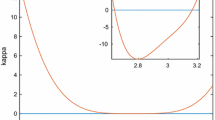Abstract
We consider a reaction-diffusion model which describes the spatial Wolbachia spread dynamics for a mixed population of infected and uninfected mosquitoes. By using linearization method, comparison principle and Leray-Schauder degree theory, we investigate the influence of diffusion on the Wolbachia infection dynamics. After identifying the system parameter regions in which diffusion alters the local stability of constant steady-states, we find sufficient conditions under which the system possesses inhomogeneous steady-states. Surprisingly, our mathematical analysis, with the help of numerical simulations, indicates that diffusion is able to lower the threshold value of the infection frequency over which Wolbachia can invade the whole population.
Similar content being viewed by others
References
Bian G W, Xu Y, Lu P, et al. The endosymbiotic bacterium Wolbachia induces resistance to dengue virus in Aedes aegypti. PLoS Pathog, 2010, 6: e1000833
Calisher C H. Persistent emergence of dengue. Emerg Infect Dis, 2005, 11: 738–739
Caspari E, Watson G S. On the evolutionary importance of cytoplasmic sterility in mosquitoes. Evolution, 1959, 13: 568–570
Casten R G, Holland C J. Stability properties of solutions to systems of reaction-diffusion equations. SIAM J Appl Math, 1977, 33: 353–364
Henry D. Geometric Theory of Semilinear Parabolic Equations. Berlin-New York: Springer-Verlag, 1981
Hoffmann A A, Montgomery B L, Popovici J, et al. Successful establishment of Wolbachia in Aedes populations to suppress dengue transmission. Nature, 2011, 476: 454–457
Hoffmann A A, Turelli M. Cytoplasmic incompatibility in insects. In: Influential Passengers: Inherited Microorganisms and Arthropod Reproduction. Oxford: Oxford University Press, 1997, 42–80
Hoffmann A A, Turelli M, Harshman L G. Factors affecting the distribution of cytoplasmic incompatibility in Drosophila simulans. Genetics, 1990, 126: 933–948
Hu L C, Huang M G, Tang M X, et al. Wolbachia spread dynamics in stochastic environments. Theo Popu Bio, 2015, 106: 32–44
Huang M G, Tang M X, Yu J S. Wolbachia infection dynamics by reaction-diffusion equations. Sci China Math, 2015, 58: 77–96
Iida M, Muramatsu T, Ninomiya H, et al. Diffusion-induced extinction of a superior species in a competition system. Japan J Indust Appl Math, 1998, 15: 233–252
Iturbe-Ormaetxe I, Walker T, O’Neill S L. Wolbachia and the biological control of mosquito-borne disease. EMBO Reports, 2011, 12: 508–518
Jiang J F, Liang X, Zhao X Q. Saddle point behavior for monotone semiflows and reaction diffusion models. J Differential Equations, 2004, 203: 313–330
Keeling M J, Jiggins F M, Read J M. The invasion and coexistence of competing Wolbachia strains. Heredity, 2003, 91: 382–388
Kishimoto K, Weinberger H. The spatial homogeneity of stable equilibria of some reaction-diffusion systems on convex domains. J Differential Equations, 1985, 58: 15–21
Kyle J L, Harris E. Global spread and persistence of dengue. Annu Rev Microbiol, 2008, 62: 71–92
Mcmeniman C J, Lane R V, Cass B N, et al. Stable introduction of a life-shortening Wolbachia infection into the mosquito Aedes aegypti. Science, 2009, 323: 141–144
Ni W-M, Tang M X. Turing patterns in the Lengyel-Epstwin system for the CIMA rection. Trans Amer Math Soc, 2005, 357: 3953–3969
Nirenberg L. Topics in Nonlinear Functional Analysis. New York: Courant Institute of Mathematical Science, 1973
Pang Y, Wang M X. Non-constant positive steady-states of a predator-prey system with non-monotonic functional response and diffusion. Proc Lond Math Soc, 2004, 88: 137–157
Protter M H, Weinberger H F. Maximum Principles in Differential Equations. Berlin-New York: Springer-Verlag, 1984
Rabinowitz P. Some global results for nonlinear eigenvalue problems. J Funct Anal, 1971, 7: 487–513
Smith H L. Monotone Dynamical Systems, An Introduction to the Theory of Competitive and Cooperative Systems. Providence: Amer Math Soc, 1995
Turelli M, Hoffmann A A. Microbe-induced cytoplasmic incompatibility as a mechanism for introducing transgenes into arthropod populations. Insect Mol Biol, 1999, 8: 243–255
Turing A M. The chemical basis of morphogenesis. Philos Trans R Soc Lond Ser B, 1952, 237: 37–72
Walker T, Johnson P H, Moreira L A, et al. The wMel Wolbachia strain blocks dengue and invades caged Aedes aegypti populations. Nature, 2011, 476: 450–453
Weinberger H F. Invariant sets for weakly coupled parabolic and elliptic systems. Rend Mat, 1975, 8: 295–310
Xi Z, Dean J L, Khoo C, et al. Generation of a novel Wolbachia infection in Aedes albopictus (Asian tiger mosquito) via embryonic microinjection. Insect Biochem Mol Biol, 2005, 35: 903–910
Xi Z, Khoo C C, Dobson S L. Wolbachia establishment and invasion in an Aedes aegypti laboratory population. Science, 2005, 310: 326–328
Zheng B, Tang M X, Yu J S. Modeling Wolbachia spread in mosquitoes through delay differential equation. SIAM J Appl Math, 2014, 74: 743–770
Author information
Authors and Affiliations
Corresponding author
Rights and permissions
About this article
Cite this article
Huang, M., Yu, J., Hu, L. et al. Qualitative analysis for a Wolbachia infection model with diffusion. Sci. China Math. 59, 1249–1266 (2016). https://doi.org/10.1007/s11425-016-5149-y
Received:
Accepted:
Published:
Issue Date:
DOI: https://doi.org/10.1007/s11425-016-5149-y
Keywords
- dengue fever
- Wolbachia infection dynamics
- cytoplasmic incompatibility mechanism
- attractive region
- Turing instability
- non-constant steady-states




